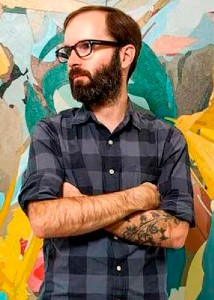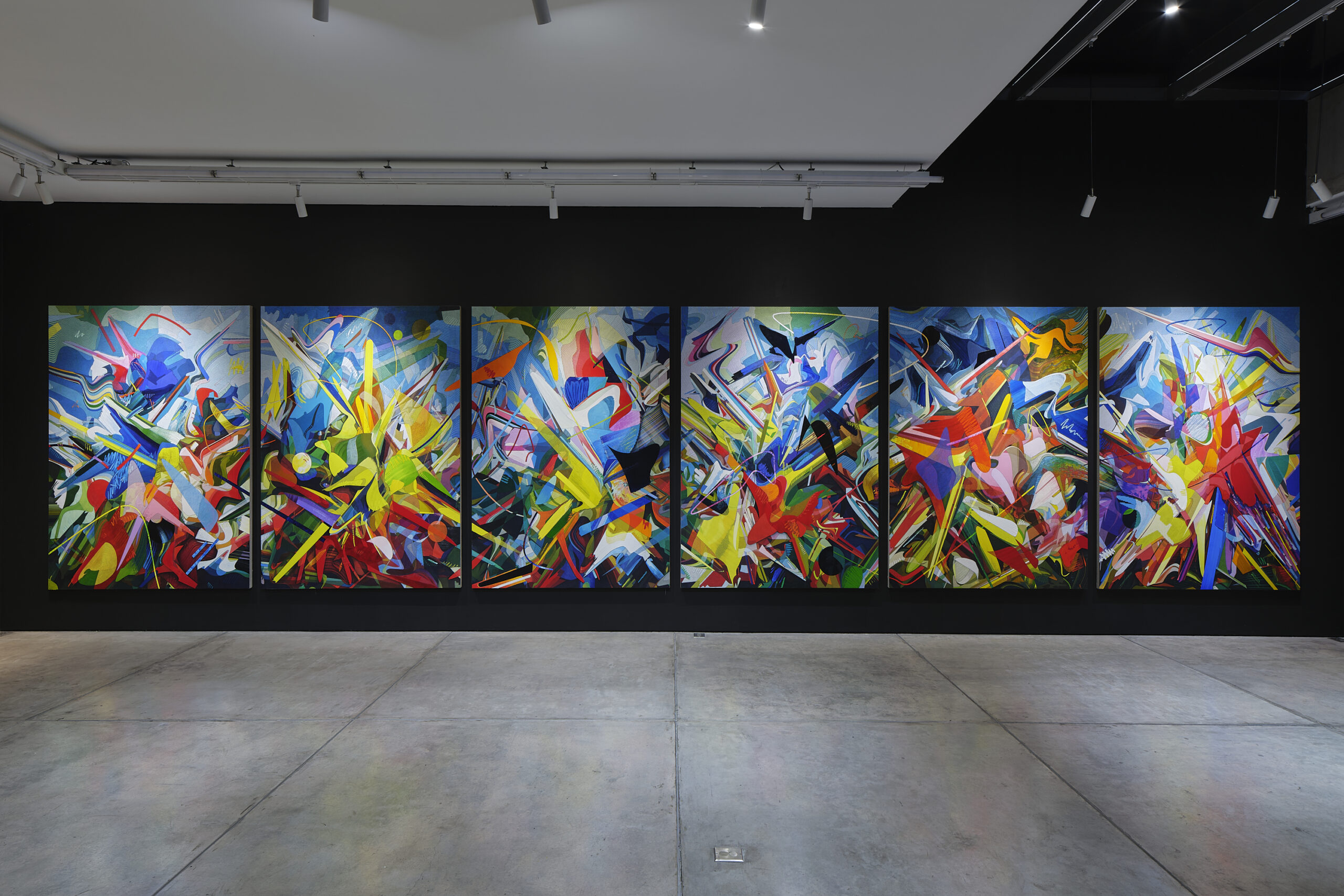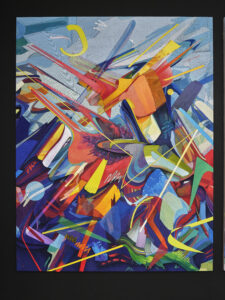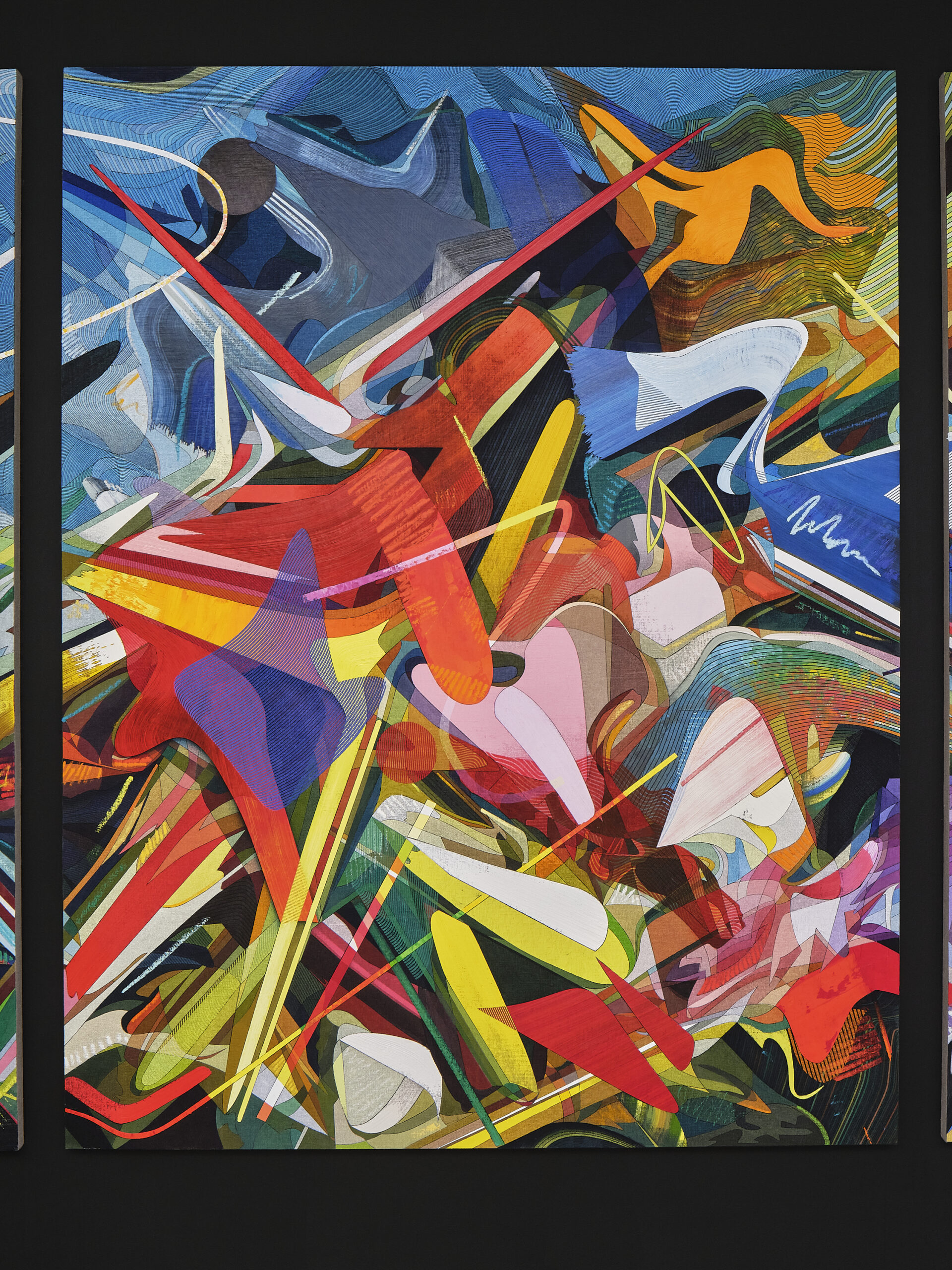Omar Rodríguez- Graham
ARTIST
Omar Rodríguez-Graham (Ciudad de México, b. 1978)
Pintura

FEBRERO 2022
Memoria e historia en la pintura.
Entrevista con Omar Rodríguez-Graham
Por Regina de Con Cossío
Fotografías cortesía de Arróniz, Arte Contemporáneo.
El trabajo de Omar Rodríguez-Graham parte de un proceso artístico en el que se vincula la investigación visual y la técnica. Sus obras están conformadas por referencias que provienen de la historia de la pintura y que, al ser yuxtapuestas a manera de un collage bidimensional, construye una nueva imagen capaz de provocar nuestra memoria. En esta conversación comparte sobre sus metodologías, sus intereses y la forma en la que trabaja con la memoria y la historia sin llevar a la pintura a un estado de narración contemplativa.

Regina De Con Cossío: ¿Tienes una metodología para las creaciones artísticas (específicamente para la pintura)? ¿En qué consisten?
Omar Rodríguez-Graham: Yo diría que tengo una metodología que se basa en la idea de la construcción de la pintura, para mí lo importante cuando empiezo a hacer una obra de arte es, en realidad, tratar de entablar una conversación con diversos momentos en el arco histórico de la pintura y, a partir de eso, extraer elementos, ya sean imágenes o técnicas, de esas piezas para después generar una construcción más de mi propia actualidad. Eso quiere decir que trato de cierta manera la historia de la pintura y las imágenes que recopilo de esta historia como tipos de sampleos que al modularlas se generan composiciones que en sí funcionan para presentar de una manera muy clara y transparente el método de la construcción pictórica. Yo lo que quiero es que la pintura funcione como un tipo de registro en el cual se documente su propio acto de construcción, de creación, porque para mí esa transparencia y esa evidenciación de la mano del artista, del proceso del artista es sumamente importante.
RCC: En una entrevista con Daniela Pérez mencionas que las pinturas, mientras más esculturales, menos narrativas. Me interesaría que explicaras un poco más sobre tu posición frente a las narrativas. En muchos espacios se dice que una pintura no puede ser narrativa porque no necesariamente cuenta una historia. Sin embargo, cuando haces una serie de pinturas que giran alrededor del mismo tema, aunque no haya una historia que contar, hay cierta narratividad. ¿Crees que se puedan encontrar historias ocultas en tus pinturas?

Omar Rodríguez- Graham. First Essay 2022 Mixta sobre Tela 2.20 x 17 m
ORG: A lo que me refería en esa entrevista con Daniela Pérez en donde mencionaba yo que mientras una obra es más estructural es menos narrativa, lo que yo trato es de encontrar una manera de a través de la estructura de la composición de los elementos formales de una obra de arte, esos mismos atrapen más al espectador y que nos alejen de la idea de la imagen como algo que cuenta una historia didáctica, a mí en realidad no me interesa tanto el tema narrativo en términos de que yo use la pintura como un tipo de ilustración de un suceso, la pintura en sí es el suceso, ahora eso no quiere decir que dentro de esa catástrofe como diría Gilles Deleuze, o esa exploración pictórica que suceda en cada obra no haya elementos narrativos, eso sería imponerle una visión completamente tajante al espectador, para mí es más importante dejar la libertad del encuentro ante el espectador y la obra de arte para que el espectador encuentre su propio camino, que desde ese encuentro, ese espacio de choque entre la obra del arte y el observador se genere una experiencia que tal vez lleve al espectador a una experiencia narrativa o a un cuento o a algo más literario pero a la mera hora lo que es importante para mí no es tanto el presentar una historia sino dejar abierta la interpretación para que el espectador encuentre su propio camino, de cierta manera lo que acaba pasando es que la obra de arte se vuelve un generador o una semilla que germina en la mente y de ahí se encuentra su propia identidad pero cada identidad es muy subjetiva no es una identidad compartida entre todos los espectadores, y ahí es en donde puede haber esta idea de la narratividad o la historia que se va contando a través de la obra de arte pero siempre parte de la posibilidad de que el encuentro es un encuentro entre el espectador como individuo y la relación que se genera es una relación completamente única.
RCC: En esa misma entrevista mencionas que muchas veces creas imágenes que, de alguna manera, mantienen una distancia con la realidad en la que te desenvuelves. Dices: “Al fin y al cabo, el efecto de esta introspección y de pintar la temática menos crítica que uno pudiera imaginar, mientras el mundo en el que uno habita está en tal caos, es en sí una crítica de ese mundo. En muchos aspectos me siento semejante a Morandi, pintando pequeños bodegones honestos mientras Europa era devorada por la guerra”. Sin embargo, en los tiempos recientes las manifestaciones artísticas coyunturales están por todos lados: hay arte para combatir el cambio climático, arte colectivo para resolver problemas sociales, arte de denuncia, arte político para reflexionar sobre los malestares de la sociedad. ¿Cuál es tu posición alrededor de estos ejemplos?
ORG: Mi posición es una posición de un interés individual, no hay una manera correcta de hacer arte, punto. A mí no me interesa el arte didáctico, no me interesa el arte que se reduce a un mensaje, es parte del problema que tengo mucho del arte contemporáneo hoy en día que se enfoca en ilustrar una idea o una teoría pero en realidad se cierra la posibilidad de descubrimiento, de creación, de accidente, que en realidad le impone una visión tajantemente a la persona que la percibe. Para mí es importante que la obra sea libre para que, como dije anteriormente, el espectador pueda encontrar su propio camino, al fin y al cabo para mí el alejarme del arte literal, no la figuración en sí porque la figuración sigue existiendo en mi trabajo, sino la figuración que impone una visión uni-ocular con solamente un punto de vista, no me interesa, yo pienso que yo sigo trabajando dentro de mi propia práctica encontrando un camino particular para mí que de cierta manera trata de darle la vuelta y no seguir el camino de abordar directamente las temáticas a mi alrededor, pero eso no quiere decir que el cambio climático, que los problemas de la sociedad, la violencia, no permeen en mi trabajo, más bien hay que reconocer que el creador crea no en una burbuja sino que el creador genera una obra a partir de su propia realidad y la realidad para mí en este momento es una realidad que está afectada por todas esas situaciones, el artista no puede escapar de su realidad, más bien trabaja desde su perspectiva de cómo lo afecta esa realidad.
RDCC: Entre los conceptos que acompañan tu obra se pueden mencionar la reminiscencia pictórica, la anamnesis, que ya has explicado en diferentes ocasiones. Yo te quiero preguntar sobre este concepto pero en otras esferas. Por ejemplo, en un juicio donde los testigos tienen que declarar, con base en su memoria, sobre un asesinato. O en el periodismo: el testigo de una noticia debe declarar para que eso se publique y forme parte de los relatos de nuestra sociedad. ¿Tus pinturas en algún momento tienen en cuenta este proceso de reminiscencia de otras esferas? ¿Cómo funciona el diálogo entre las reminiscencias artísticas y las de la realidad?
ORG: Para mí, el tema de la memoria o la anamnesis es una manera de considerar la memoria como una una memoria imperfecta, pero completamente perfecta; es decir, la memoria es una memoria verídica, pero no es verídica en el sentido como lo es la mimesis o algo que representa algo que realmente sucedió, si no es es algo que representa o es la memoria de cómo se percibió, cómo se sintió en ese momento. La anamnesis como la memoria en realidad es un tema personal, mi realidad de lo que sucedió nunca será la misma realidad que para alguien más. Creo que mi trabajo sigue trabajando con eso. La memoria dentro de la formulación de mis propias pinturas es sumamente importante porque aunque yo hablo de poder entablar un discurso con diferentes momentos históricos y de apropiarme de diferentes técnicas, esas técnicas no son copias literales o copias perfectas de cómo lo hacían otros artistas, más bien pasan por ese filtro de memoria, entonces cuando yo veo unos círculos en un cielo de Van Gogh los traduzco a través de mi memoria pensando en cómo podrían haber sido sin en realidad hace referencia directa a la imagen o a la técnica o el método constructivo de cómo lo hizo él. Al igual los puntos de Liechtenstein o líneas de grabado japonés, todo es filtrado a través de la memoria que es imperfecta pero completamente fiel a como yo lo percibo, entonces mi diálogo con el arte, con la historia del arte, siempre está filtrado a través de mi propia percepción de eso y es parte de lo que es interesante para mí es viajar y recopilar estas memorias que aunque imperfectas en el mundo de la veracidad de reproducción de técnica, son completamente fieles a la manera que yo las percibí y en torno a cómo yo las estoy aplicando dentro de mi trabajo.
RDCC: Algunos galeristas y agentes que trabajan en el mercado del arte, han manifestado que la pintura es una de las disciplinas más vivas en cuanto su valor económico se refiere: durante la pandemia la gente siguió comprando pintura, quizá como ningún otro objeto artístico. ¿A qué crees que se deba este fenómeno?
ORG: La pintura goza de una posición privilegiada dentro del mercado del arte y lo ha gozado desde hace mucho tiempo. Aunque se hable de que la pintura pierde fuerza, el mercado y el interés por ella siempre ha estado muy presente. Yo creo que durante la pandemia mucha gente veía la pintura como una manera de escapar a otro espacio porque tal vez a diferencia de otros medios de formulación de imágenes, la pintura tiene algo muy específico, muy contundente que es que no es una imagen completamente cerrada, sino un espacio que se genera lleno de posibilidad de descubrimiento porque es un documento que registra la mano su propia creación, su construcción y al ser así es algo abre un espacio infinito. Al ser percibido no es una imagen limitada algo mimético, no es una ilustración, no es un diagrama, es algo profundamente más complejo, y creo que eso como siempre ha llamado la atención del coleccionismo y más ahora que la gente está encerrada en sus casas.
RDCC:Desde tu punto de vista, ¿cuál es el momento que vive la pintura en México?
ORG: Yo pienso que estamos en un momento muy afortunado en México donde la pintura está recobrando una energía que no había tenido tal vez en 30 o 40 años. Creo que las instituciones, los coleccionistas, las galerías más que nada han estado apuntando y apostando por pintores jóvenes de técnicas diversas, ideas diversas; acercamientos diversos a cómo puede ser una pintura. La pintura hoy en día es tan diversa como nunca ha sido antes. La vemos en el campo expandido en donde la pintura tal vez ya ni está hecha con pigmentos y color, sino en la instalación, o podemos ser completamente tradicionales y hacer pinturas que son completamente figurativas o abstractas o gestuales. Yo creo que vivimos un momento en donde la pintura en México ha recobrado un sentido porque durante muchos años tuvimos un equipo de segunda ruptura en contra de la pintura que se llevó a cabo por un interés en el arte conceptual. Yo creo que afortunadamente se ha quitado la ceguera de que el arte contemporáneo no puede ser formal y gracias a eso hemos empezado a ver que la pintura como otras artes más manuales, más tradicionales están cobrando mucho más fuerza y lo único que creo que resulta de esta diversidad es que hay una efervescencia en la escena mexicana del arte porque ya no estamos reduciendo la visión de lo que puede ser el arte mexicano o el arte conceptual y eso yo lo agradezco tremendamente.
Memory and history in painting
Interview with Omar Rodríguez-Graham
By Regina de Con Cossío
Photographs courtesy of Arróniz, Arte Contemporáneo.


Regina De Con Cossío: Do you have a methodology for artistic creations (specifically for painting)? What does it consist of?
Omar Rodríguez – Graham: I would say that I have a methodology that is based on the idea of the construction of painting. For me, the important thing when I start to make a work of art is actually trying to start a conversation with different moments in the historical arc of painting and, from that, extract elements, whether images or techniques, from those pieces to later generate another construction of my own current situation. That means that I treat in a certain way the history of painting and the images that I collect from this history as types of samples that, when modulated, generate compositions that in themselves work to present the method of pictorial construction in a very clear and transparent way. What I want is for painting to function as a type of record in which its own act of construction, of creation, is documented, because for me that transparency and that evidence of the artist’s hand, of the artist’s process, is extremely important.
RCC: In an interview with Daniela Pérez you mention that the paintings, the more sculptural, the less narrative. Could you explain a little bit more about your position regarding narratives. In many spaces it is said that a painting cannot be narrative because it does not necessarily tell a story. However, when you make a series of paintings that revolve around the same theme, even though there is no story to tell, there is a certain narrative. Do you think that hidden stories can be found in your paintings?
ORG: What I was referring to in that interview with Daniela Pérez where I mentioned that while a work is more structural it is less narrative, what I try to do is find a way through the structure of the composition of the formal elements of a work of art, those same ones that catch the viewer more and that move us away from the idea of the image as something that tells a didactic story.
I’m not really that interested in the narrative theme in terms of my using the painting as a kind of illustration of an event, the painting itself is the event, now that doesn’t mean that within that catastrophe, as Gilles would say Deleuze, or that pictorial exploration that happens in each work, there are no narrative elements, that would be to impose a completely unequivocal vision on the viewer. For me it is more important to leave the freedom of the encounter between the spectator and the work of art so that the spectator finds his own path, that from that encounter, that space of clash between the work of art and the observer, an experience is generated that such Maybe take the viewer into a narrative experience or a story or something more literary.
What is important to me is not so much presenting a story but rather leaving the interpretation open so that the viewer can find their own path, in a certain way what ends up happening is that the work of art becomes a generator or a seed that germinates in the mind and from there its own identity is found, but each identity is very subjective, it is not an identity shared among all the spectators, and that is where there can be this idea of narrativity or the story that is told through the work of art but always starts from the possibility that the encounter is an encounter between the spectator as an individual and the relationship that is generated is a completely unique relationship.
RCC: In that same interview you mention that you often create images that, in some way, maintain a distance from the reality in which you live. You say: “Ultimately, the effect of this introspection and of painting the most uncritical subject matter one could imagine, while the world one inhabits is in such chaos, is itself a critique of that world. In many ways I feel like Morandi, painting honest little still lifes while Europe was devoured by war. However, in recent times, conjunctural artistic manifestations are everywhere: there is art to combat climate change, collective art to solve social problems, art of denunciation, political art to reflect on the discomforts of society. What is your position around these examples?
ORG: My position is a position of individual interest, there is no right way to make art, period. I am not interested in didactic art, I am not interested in art that is reduced to a message, it is part of the problem that I have with a lot of contemporary art that focuses on illustrating an idea or a theory but in reality it closes the possibility of discovery, creation, accident, which actually imposes a vision sharply on the person who perceives it.
For me it is important that the work be free so that, as I said before, the viewer can find their own way. I distance myself from literal art, not from figuration per se because figuration continues to exist in my work, but figuration that imposes a one-eyed vision with only one point of view, that doesn’t interest me. I think that I continue to work within my own practice, finding a particular path for myself that in a certain way tries to turn it around and not follow the path of directly addressing the issues around me, but that does not mean that climate change, that the problems of society, violence, do not permeate my work, rather we must recognize that the creator does not create in a bubble but that the creator generates a work from his own reality, and reality for me in this moment is a reality that is affected by all these situations, the artist cannot escape his reality, rather he works from his perspective of how that reality affects him.cannot escape from his reality, rather he works from his perspective of how that reality affects him.
RCC:Among the concepts that accompany your work we can mention the pictorial reminiscence, the anamnesis, which you have already explained on different occasions. I want to ask you about this concept but in other spheres. For example, in a trial where witnesses have to testify, based on their memory, about a murder. Or in journalism: the witness of a piece of news must testify so that it gets published and becomes part of the stories of our society. Do your paintings ever take into account this process of reminiscence of other spheres? How does the dialogue between artistic reminiscences and those of reality work?
ORG: For me, the subject of memory or anamnesis is a way of considering memory as an imperfect but completely perfect memory, that is, memory is a true memory but it is not true as mimesis or something that represents something that actually happened, it represents something as perceived, how you felt at the time. The anamnesis as memory is actually a personal issue, my reality of what happened will never be the same reality as someone else’s, my art continues to work on that.
The memory within the formulation of my own paintings is extremely important because although I speak of being able to engage in a discourse with different historical moments and of appropriating different techniques, these techniques are not literal copies or perfect copies of how other artists did it because they pass through that memory filter, so when I see some circles in a Van Gogh sky, I translate them through my memory, thinking about how they could have been without actually making direct reference to the image or the technique or construction method of how he did it, that also happens with the dots of Liechtenstein or the lines of Japanese engraving, everything is filtered through a memory that is imperfect but completely faithful to how I perceive it. My dialogue with art, with art history, is always filtered through my own perception of it and part of what is interesting for me is traveling and collecting these memories that, although imperfect in the world of reproduction truthfulness of technique, they are completely faithful to the way I perceived them and how I am applying them in my work.
RCC: Some gallery owners and agents who work in the art market have stated that painting is one of the liveliest disciplines in terms of its economic value: during the pandemic, people continued to buy painting, perhaps like no other art object. What do you think is the reason for this phenomenon?
ORG: The privileged position of a painting within the art market has been popular for a long time and although there is a conversation of painting losing strength, the market and the interest in paintings has always been very present. I think that during the pandemic many people saw painting as a way of escaping to another space because perhaps unlike other means of formulating images, painting has something very specific, very forceful, which is that it is not a completely closed image, but rather a space that is generated and that is full of discovery opportunities because it is a document where the hand registers its own creation, its construction and being like this it is something that opens an infinite space for, when perceived it is not a limited image, something mimetic. It is not an illustration, it is not a diagram, it is something profoundly more complex, and I think that, as it has always attracted the attention of collecting and more now that people are locked up in their homes.
RCC: From your point of view, what is the moment that painting in Mexico is experiencing?
ORG: I think that we are in a very fortunate moment in Mexico where painting is recovering an energy that it had not had in perhaps 30 or 40 years. I think that the institutions, the collectors, the galleries, more than anything else, have been aiming and betting by young painters with diverse techniques, diverse ideas, diverse approaches to what a painting can be like. Painting today is as diverse as it has ever been before, we see it in the expanded field where painting is perhaps not done with pigments and color anymore, but rather in installation, or we can be completely traditional and make paintings that are wholly figurative or abstract or gestural. I believe that we live in a moment in which painting in Mexico has regained meaning because for many years we had a team of second rupture against painting that was carried out by an interest in conceptual art. I believe that fortunately the blindness that contemporary art cannot be formal has been removed and thanks to that we have begun to see that painting, like other more manual, more traditional arts, is gaining much more strength. The only thing that I think results from this diversity is that there is an effervescence in the Mexican art scene because we are no longer reducing the vision of what Mexican art or conceptual art can be, and I am tremendously grateful for that.


